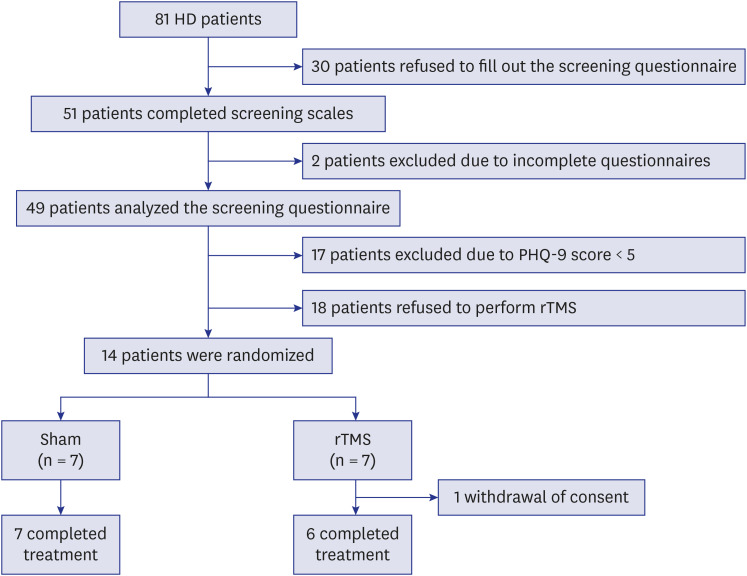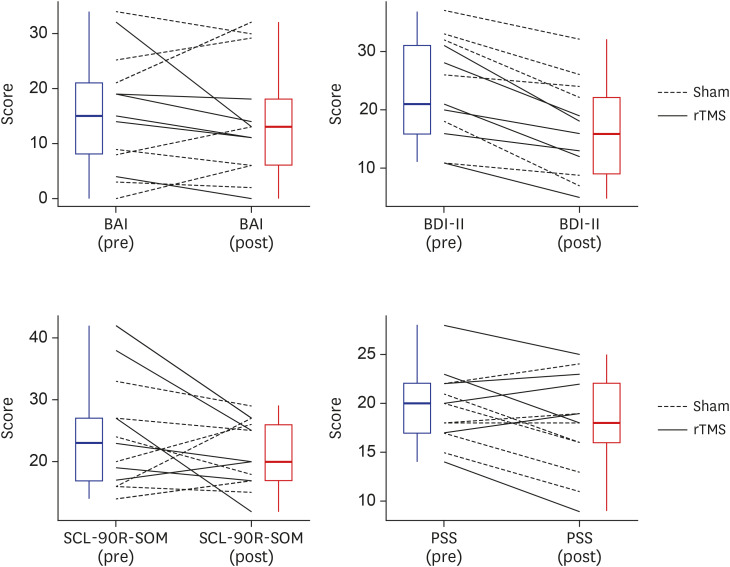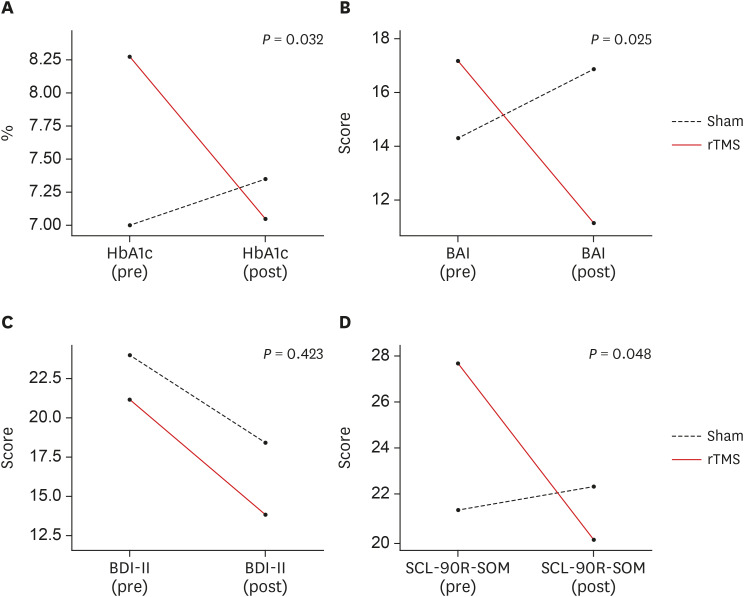J Korean Med Sci.
2020 Jul;35(26):e205. 10.3346/jkms.2020.35.e205.
Effects of Repetitive Transcranial Magnetic Stimulation on Improvement of Mental Health and Clinical Parameters in Depressed Hemodialysis Patients: a Pilot Study
- Affiliations
-
- 1Division of Nephrology, Department of Internal Medicine, Chung-Ang University Hospital, Seoul, Korea
- 2Department of Psychiatry, Chung-Ang University Hospital, Seoul, Korea
- KMID: 2503679
- DOI: http://doi.org/10.3346/jkms.2020.35.e205
Abstract
- Background
This study aimed to evaluate the therapeutic effect of repetitive transcranial magnetic stimulation (rTMS) as a nonpharmacologic treatment in depressed hemodialysis patients.
Methods
Patients who scored ≥ 5 on the Patient Health Questionnaire-9 were randomized to either the rTMS (n = 7) or sham group (n = 7). The rTMS group was stimulated with a 110% motor threshold and 10 Hz on the left dorsolateral prefrontal cortex for 20 minutes, three times a week, for 4 weeks. In the sham group, the “1-wing 90-degree method” was used. We analyzed clinical indices before and after the intervention, as well as data from quantitative electroencephalography (frontal alpha asymmetry [FAA]), and various psychiatric questionnaires (Beck Depression Inventory-II, Beck Anxiety Inventory [BAI], Symptom Checklist-90-Revised Somatization Subscale [SCL-90R-SOM]), and Perceived Stress Scale.
Results
One month after rTMS, the changes in hemoglobin A1c levels in the rTMS group were significantly greater than those in the sham group (F = 6.687, P = 0.032). The changes in BAI scores in the rTMS group were significantly greater than those in the sham group (F = 6.700, P = 0.025), and the changes in SCL-90R-SOM scores in the rTMS group were greater than those in the sham group (F = 4.943, P = 0.048). In addition, the changes in the FAA value at the F7 and F8 electrodes in the rTMS group were greater than those in the sham group (F = 6.468, P = 0.027).
Conclusion
In depressed hemodialysis patients, rTMS may improve anxiety and somatization symptoms, which may lead to improvements in clinical measures.
Keyword
Figure
Reference
-
1. Saglimbene V, Palmer S, Scardapane M, Craig JC, Ruospo M, Natale P, et al. Depression and all-cause and cardiovascular mortality in patients on haemodialysis: a multinational cohort study. Nephrol Dial Transplant. 2017; 32(2):377–384. PMID: 28186569.
Article2. Watnick S, Kirwin P, Mahnensmith R, Concato J. The prevalence and treatment of depression among patients starting dialysis. Am J Kidney Dis. 2003; 41(1):105–110. PMID: 12500227.
Article3. Hedayati SS, Minhajuddin AT, Afshar M, Toto RD, Trivedi MH, Rush AJ. Association between major depressive episodes in patients with chronic kidney disease and initiation of dialysis, hospitalization, or death. JAMA. 2010; 303(19):1946–1953. PMID: 20483971.
Article4. George MS, Lisanby SH, Avery D, McDonald WM, Durkalski V, Pavlicova M, et al. Daily left prefrontal transcranial magnetic stimulation therapy for major depressive disorder: a sham-controlled randomized trial. Arch Gen Psychiatry. 2010; 67(5):507–516. PMID: 20439832.5. O'Reardon JP, Solvason HB, Janicak PG, Sampson S, Isenberg KE, Nahas Z, et al. Efficacy and safety of transcranial magnetic stimulation in the acute treatment of major depression: a multisite randomized controlled trial. Biol Psychiatry. 2007; 62(11):1208–1216. PMID: 17573044.6. Wagner T, Valero-Cabre A, Pascual-Leone A. Noninvasive human brain stimulation. Annu Rev Biomed Eng. 2007; 9:527–565. PMID: 17444810.
Article7. Liston C, Chen AC, Zebley BD, Drysdale AT, Gordon R, Leuchter B, et al. Default mode network mechanisms of transcranial magnetic stimulation in depression. Biol Psychiatry. 2014; 76(7):517–526. PMID: 24629537.
Article8. Salomons TV, Dunlop K, Kennedy SH, Flint A, Geraci J, Giacobbe P, et al. Resting-state cortico-thalamic-striatal connectivity predicts response to dorsomedial prefrontal rTMS in major depressive disorder. Neuropsychopharmacology. 2014; 39(2):488–498. PMID: 24150516.
Article9. McClintock SM, Reti IM, Carpenter LL, McDonald WM, Dubin M, Taylor SF, et al. Consensus recommendations for the clinical application of repetitive transcranial magnetic stimulation (rTMS) in the treatment of depression. J Clin Psychiatry. 2018; 79(1):16cs10905.
Article10. Moynihan JA, Chapman BP, Klorman R, Krasner MS, Duberstein PR, Brown KW, et al. Mindfulness-based stress reduction for older adults: effects on executive function, frontal alpha asymmetry and immune function. Neuropsychobiology. 2013; 68(1):34–43. PMID: 23774986.
Article11. Harmon-Jones E. Contributions from research on anger and cognitive dissonance to understanding the motivational functions of asymmetrical frontal brain activity. Biol Psychol. 2004; 67(1-2):51–76. PMID: 15130525.
Article12. Coan JA, Allen JJ. Frontal EEG asymmetry as a moderator and mediator of emotion. Biol Psychol. 2004; 67(1-2):7–49. PMID: 15130524.
Article13. Cook IA, Hunter AM, Gilmer WS, Iosifescu DV, Zisook S, Burgoyne KS, et al. Quantitative electroencephalogram biomarkers for predicting likelihood and speed of achieving sustained remission in major depression: a report from the biomarkers for rapid identification of treatment effectiveness in major depression (BRITE-MD) trial. J Clin Psychiatry. 2013; 74(1):51–56. PMID: 23419226.14. Barnhofer T, Duggan D, Crane C, Hepburn S, Fennell MJ, Williams JM. Effects of meditation on frontal alpha-asymmetry in previously suicidal individuals. Neuroreport. 2007; 18(7):709–712. PMID: 17426604.15. Rabe S, Zoellner T, Beauducel A, Maercker A, Karl A. Changes in brain electrical activity after cognitive behavioral therapy for posttraumatic stress disorder in patients injured in motor vehicle accidents. Psychosom Med. 2008; 70(1):13–19. PMID: 17991819.
Article16. Hong JS, Kim SM, Kang KD, Han DH, Kim JS, Hwang H, et al. Effect of physical exercise intervention on mood and frontal alpha asymmetry in internet gaming disorder. Ment Health Phys Act. 2020; 18:100318.
Article17. Hedayati SS, Yalamanchili V, Finkelstein FO. A practical approach to the treatment of depression in patients with chronic kidney disease and end-stage renal disease. Kidney Int. 2012; 81(3):247–255. PMID: 22012131.18. Kroenke K, Spitzer RL, Williams JB. The PHQ-9: validity of a brief depression severity measure. J Gen Intern Med. 2001; 16(9):606–613. PMID: 11556941.19. First M, Williams J, Karg R, Spitzer R. Structured Clinical Interview for DSM-5 Disorders-Clinician Version (SCID5-CV). Arlington, VA: American Psychiatric Association;2015.20. Beck AT, Epstein N, Brown G, Steer RA. An inventory for measuring clinical anxiety: psychometric properties. J Consult Clin Psychol. 1988; 56(6):893–897. PMID: 3204199.
Article21. Derogatis LR. SCL-90-R: Administration, Scoring & Procedures Manual-II for the Revised Version and Other Instruments of The Psychopathology Rating Scale Series. Towson, MD: Clinical Psychometric Research, Inc.;1992.22. Cohen S, Williamson G. Perceived stress in a probability sample of the United States. In : Spacapan S, Oskamp S, editors. The Social Psychology of Health: Claremont Symposium on Applied Social Psychology. Newbury Park, CA: Sage;1988. p. 31–67.23. Charlson M, Szatrowski TP, Peterson J, Gold J. Validation of a combined comorbidity index. J Clin Epidemiol. 1994; 47(11):1245–1251. PMID: 7722560.
Article24. Park JY, Kim MH, Han SS, Cho H, Kim H, Ryu DR, et al. Recalibration and validation of the Charlson comorbidity index in Korean incident hemodialysis patients. PLoS One. 2015; 10(5):e0127240. PMID: 25984790.
Article25. van Manen JG, Korevaar JC, Dekker FW, Boeschoten EW, Bossuyt PM, Krediet RT, et al. How to adjust for comorbidity in survival studies in ESRD patients: a comparison of different indices. Am J Kidney Dis. 2002; 40(1):82–89. PMID: 12087565.
Article26. Wu PH, Lin YT, Lee TC, Lin MY, Kuo MC, Chiu YW, et al. Predicting mortality of incident dialysis patients in Taiwan--a longitudinal population-based study. PLoS One. 2013; 8(4):e61930. PMID: 23626754.27. Ghimire S, Castelino RL, Lioufas NM, Peterson GM, Zaidi ST. Nonadherence to medication therapy in haemodialysis patients: a systematic review. PLoS One. 2015; 10(12):e0144119. PMID: 26636968.
Article28. Kim YI, Kim SM, Kim H, Han DH. The effect of high-frequency repetitive transcranial magnetic stimulation on occupational stress among health care workers: a pilot study. Psychiatry Investig. 2016; 13(6):622–629.
Article29. Lisanby SH, Gutman D, Luber B, Schroeder C, Sackeim HA. Sham TMS: intracerebral measurement of the induced electrical field and the induction of motor-evoked potentials. Biol Psychiatry. 2001; 49(5):460–463. PMID: 11274658.
Article30. Beck AT, Steer RA, Ball R, Ranieri W. Comparison of Beck Depression Inventories -IA and -II in psychiatric outpatients. J Pers Assess. 1996; 67(3):588–597. PMID: 8991972.31. Derogatis L. Symptom Checklist-90-R: Administration, Scoring and Procedures Manual. 3rd ed. Minneapolis, MN: National Computer Systems, Inc;1994.32. Gollan JK, Hoxha D, Chihade D, Pflieger ME, Rosebrock L, Cacioppo J. Frontal alpha EEG asymmetry before and after behavioral activation treatment for depression. Biol Psychol. 2014; 99:198–208. PMID: 24674708.
Article33. Cohen SD, Cukor D, Kimmel PL. Anxiety in patients treated with hemodialysis. Clin J Am Soc Nephrol. 2016; 11(12):2250–2255. PMID: 27660303.
Article34. Chen L, Hudaib AR, Hoy KE, Fitzgerald PB. Is rTMS effective for anxiety symptoms in major depressive disorder? An efficacy analysis comparing left-sided high-frequency, right-sided low-frequency, and sequential bilateral rTMS protocols. Depress Anxiety. 2019; 36(8):723–731. PMID: 30958907.
Article35. Yan T, Xie Q, Zheng Z, Zou K, Wang L. Different frequency repetitive transcranial magnetic stimulation (rTMS) for posttraumatic stress disorder (PTSD): a systematic review and meta-analysis. J Psychiatr Res. 2017; 89:125–135. PMID: 28278422.
Article36. Galhardoni R, Correia GS, Araujo H, Yeng LT, Fernandes DT, Kaziyama HH, et al. Repetitive transcranial magnetic stimulation in chronic pain: a review of the literature. Arch Phys Med Rehabil. 2015; 96(4):Suppl. S156–S172. PMID: 25437106.
Article37. Li CT, Su TP, Hsieh JC, Ho ST. Efficacy and practical issues of repetitive transcranial magnetic stimulation on chronic medically unexplained symptoms of pain. Acta Anaesthesiol Taiwan. 2013; 51(2):81–87. PMID: 23968659.
Article38. King-Wing Ma T, Kam-Tao Li P. Depression in dialysis patients. Nephrology (Carlton). 2016; 21(8):639–646. PMID: 26860073.39. Södeman E, Lisspers J. Diagnosing depression in patients with physical diseases using the Beck Depression Inventory (BDI). Scand J Behav Ther. 1997; 26(3):102–112.
Article40. Holt RI, de Groot M, Golden SH. Diabetes and depression. Curr Diab Rep. 2014; 14(6):491. PMID: 24743941.
Article41. Fiore V, Marci M, Poggi A, Giagulli VA, Licchelli B, Iacoviello M, et al. The association between diabetes and depression: a very disabling condition. Endocrine. 2015; 48(1):14–24. PMID: 24927794.
Article42. Berlim MT, van den Eynde F, Tovar-Perdomo S, Daskalakis ZJ. Response, remission and drop-out rates following high-frequency repetitive transcranial magnetic stimulation (rTMS) for treating major depression: a systematic review and meta-analysis of randomized, double-blind and sham-controlled trials. Psychol Med. 2014; 44(2):225–239. PMID: 23507264.
Article43. Machii K, Cohen D, Ramos-Estebanez C, Pascual-Leone A. Safety of rTMS to non-motor cortical areas in healthy participants and patients. Clin Neurophysiol. 2006; 117(2):455–471. PMID: 16387549.
Article44. Rossi S, Hallett M, Rossini PM, Pascual-Leone A. Safety of TMS Consensus Group. Safety, ethical considerations, and application guidelines for the use of transcranial magnetic stimulation in clinical practice and research. Clin Neurophysiol. 2009; 120(12):2008–2039. PMID: 19833552.
Article45. Slotema CW, Blom JD, Hoek HW, Sommer IE. Should we expand the toolbox of psychiatric treatment methods to include Repetitive Transcranial Magnetic Stimulation (rTMS)? A meta-analysis of the efficacy of rTMS in psychiatric disorders. J Clin Psychiatry. 2010; 71(7):873–884. PMID: 20361902.46. Janicak PG, O'Reardon JP, Sampson SM, Husain MM, Lisanby SH, Rado JT, et al. Transcranial magnetic stimulation in the treatment of major depressive disorder: a comprehensive summary of safety experience from acute exposure, extended exposure, and during reintroduction treatment. J Clin Psychiatry. 2008; 69(2):222–232. PMID: 18232722.
- Full Text Links
- Actions
-
Cited
- CITED
-
- Close
- Share
- Similar articles
-
- Repetitive Transcranial Magnetic Stimulation for Limb-Kinetic Apraxia in Parkinson's Disease
- Noninvasive brain stimulation: repetitive transcranial magnetic stimulation and transcranial direct current stimulation
- Application of Non-invasive Brain Stimulation on Dysphagia after Stroke
- Predictors of Response to Repetitive Transcranial Magnetic Stimulation in Depression: A Review of Recent Updates
- Repetitive transcranial magnetic stimulation for neuropathic pain





